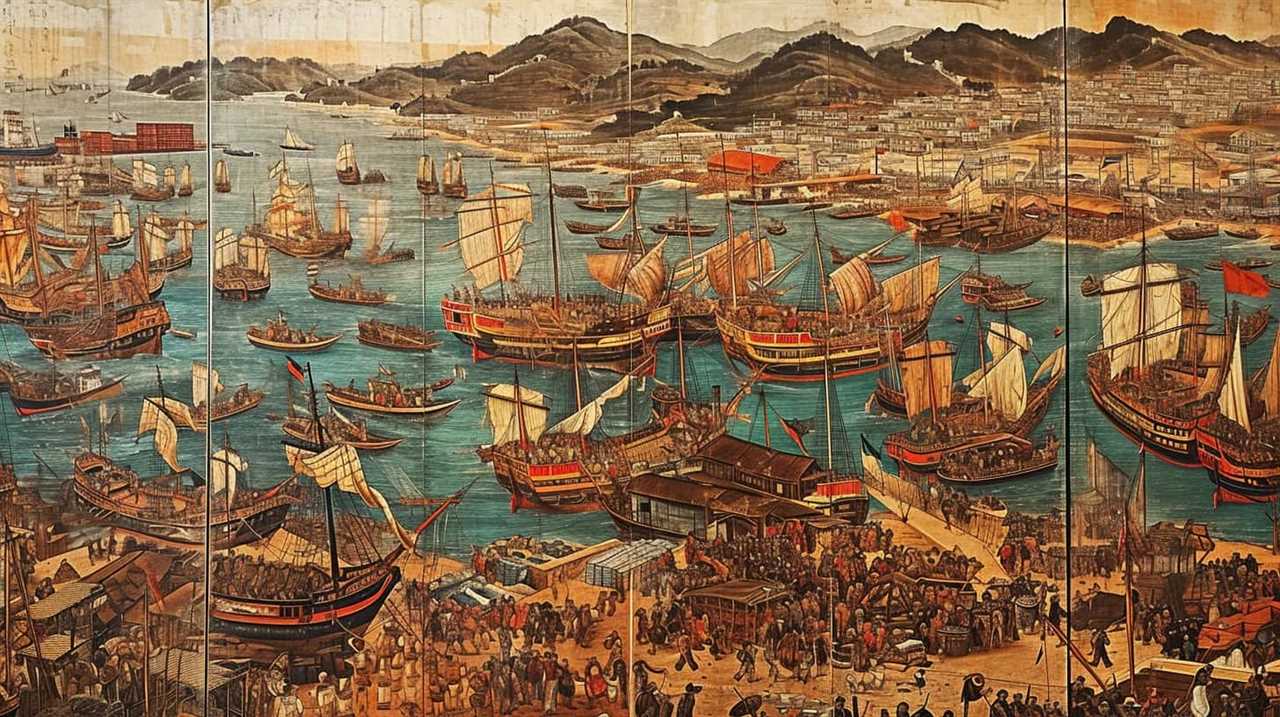Welcome to ‘Mastering Demand Analysis: Adam Smith’s Insights’!
In this innovative exploration, we delve into the revolutionary ideas of Adam Smith, the father of modern economics. Prepare to be amazed as we uncover Smith’s profound insights on supply and demand.
From his renowned concept of the ‘Invisible Hand’ to his groundbreaking understanding of market forces, Smith’s theories have shaped the very foundation of economic thought.
By understanding Smith’s insights, we gain the tools to navigate the complex landscape of demand analysis with confidence and foresight.

Join us on this journey as we unlock the secrets of Smith’s timeless wisdom and discover how his ideas continue to shape our world today.
Let’s embark on this exciting adventure together!
Key Takeaways
- Adam Smith believed that individual self-interest and competition in a free market could benefit society.
- The concept of the invisible hand highlights the role of competition and market forces in shaping the economy.
- Market equilibrium occurs when quantity demanded matches quantity supplied at a certain price.
- Understanding the impact of price changes on demand is crucial for businesses and policymakers.
Adam Smith’s Background
In our exploration of demand analysis, we must consider Adam Smith’s background and how it influenced his insights. Adam Smith, widely regarded as the father of modern economics, was a Scottish philosopher and economist who lived during the 18th century. His theories and contributions to economics have had a profound impact on the field and continue to shape our understanding today.
Smith’s background as a professor of moral philosophy at the University of Glasgow allowed him to approach economics from a unique perspective. He believed that individual self-interest, when combined with competition in a free market, could lead to the greatest overall benefit for society. This idea, known as the invisible hand concept, forms the foundation of Smith’s theories.

Through his observations and analysis, Smith recognized the importance of supply and demand in determining prices and quantities in a market economy. He emphasized the role of competition in driving innovation, efficiency, and economic growth. Smith’s work laid the groundwork for future economists to develop theories on market equilibrium, economic welfare, and the division of labor.
As we delve deeper into demand analysis, it’s crucial to understand Adam Smith’s contributions and how they’ve shaped our understanding of economic principles. With this knowledge, we can better appreciate the impact of his ideas on our modern world.
The Invisible Hand Concept
Exploring the concept of the invisible hand, we understand its significance in Adam Smith’s economic theories. Smith argued that individuals, driven by self-interest, unintentionally promote the well-being of society as a whole through their economic actions. This concept highlights the role of competition and market forces in shaping the economy.
To better understand the invisible hand concept, let’s examine the role of competition and market forces in a table:

| Competition | Market Forces |
|---|---|
| Drives innovation and efficiency | Determines prices and allocation of goods |
| Encourages businesses to improve | Influences supply and demand |
| Fosters economic growth and progress | Regulates the equilibrium of the market |
Competition plays a vital role in fostering innovation and efficiency. In a competitive market, businesses strive to offer better products at lower prices to attract customers. This drives them to constantly improve their products or services.
Market forces, on the other hand, determine the prices of goods and services and allocate resources based on supply and demand. When demand exceeds supply, prices rise, incentivizing producers to increase supply. Conversely, when supply exceeds demand, prices decrease, encouraging consumers to purchase more.
Understanding the invisible hand concept allows us to appreciate the self-regulating nature of markets. As individuals pursue their own interests, they inadvertently contribute to the overall welfare of society through the mechanism of competition and market forces. This insight remains relevant in today’s world, as we continue to study and innovate in the field of economics.
Definition of Supply and Demand
When analyzing supply and demand, it’s important to understand the concept of market equilibrium.

Market equilibrium occurs when the quantity demanded by consumers matches the quantity supplied by producers at a certain price.
Any changes in price can have a significant impact on the supply and demand dynamics, leading to shifts in market equilibrium.
Understanding these relationships is crucial for businesses and policymakers to make informed decisions and effectively respond to market conditions.
Market Equilibrium Explained
We can understand market equilibrium, the definition of supply and demand, by considering the interaction of buyers and sellers in a given market. Market equilibrium occurs when the quantity demanded by buyers matches the quantity supplied by sellers at a specific price. This balance is crucial for the smooth functioning of markets and ensures that resources are allocated efficiently. To visualize this concept, let’s consider the following table:

| Price | Quantity Demanded | Quantity Supplied |
|---|---|---|
| $10 | 100 | 50 |
| $8 | 150 | 150 |
| $6 | 200 | 250 |
| $4 | 250 | 350 |
As we can see, at a price of $8, the quantity demanded and supplied are in equilibrium. However, at prices above or below $8, there is a mismatch between the quantity demanded and supplied, leading to market dynamics and price fluctuation. Understanding market equilibrium is essential to comprehend the impact of price changes, which we will explore in the subsequent section.
Impact of Price Changes
To understand the impact of price changes on supply and demand, let’s delve into the intricacies of market dynamics and resource allocation.
When the price of a product increases, there are several effects on demand:
- Decrease in quantity demanded: Higher prices often lead to a decrease in the quantity of a product demanded by consumers. This is because consumers may find the product less affordable or may seek alternatives.
- Substitution effect: Price fluctuations can also lead consumers to substitute one product for another. For example, if the price of coffee increases, some consumers may switch to tea or other beverages instead.
- Income effect: Changes in price can also impact consumers’ purchasing power. If the price of a product increases, consumers may have less disposable income to spend on other goods and services.
Understanding these effects is crucial for businesses to make informed decisions about pricing strategies and product offerings.

These insights lay the foundation for the subsequent discussion on the law of supply and demand.
The Law of Supply and Demand
The Law of Supply and Demand is a fundamental concept in economics. It states that the price of a good or service is determined by the equilibrium between the quantity supplied and the quantity demanded.
In a competitive market, market forces such as changes in consumer preferences, input costs, and technology can impact the supply and demand curves, leading to changes in the equilibrium price.
Understanding these market forces and how they influence pricing is crucial for businesses and policymakers alike.

Equilibrium Price Determination
Determining the equilibrium price, the interplay between supply and demand sets the prevailing market rate for goods and services. In this section, we’ll delve into the concept of equilibrium price determination and explore the market dynamics that drive it. Here are three key points to consider:
- Supply and demand curves intersect: Equilibrium price occurs when the quantity demanded by consumers matches the quantity supplied by producers. At this point, there’s no shortage or surplus in the market.
- Market forces adjust prices: Any changes in supply or demand will cause the equilibrium price to shift. For instance, an increase in demand will lead to higher prices, while an increase in supply will result in lower prices.
- Price elasticity influences equilibrium: The responsiveness of supply and demand to price changes affects the equilibrium price. In markets with highly elastic demand or supply, small changes in price can have significant impacts on the equilibrium point.
Understanding the equilibrium price determination and the underlying market dynamics is crucial for businesses seeking to innovate and stay competitive in today’s rapidly changing market environment.
In the subsequent section, we’ll explore how market forces and pricing interact to shape the overall market landscape.
Market Forces and Pricing
Now, let’s delve into the interplay between market forces and pricing, as we continue our discussion on the law of supply and demand. Pricing mechanisms play a crucial role in determining the equilibrium price in a market. Market dynamics, on the other hand, refer to the various factors that influence the supply and demand of a product or service. To better understand this concept, let’s take a look at the table below:

| Pricing Mechanisms | Market Dynamics |
|---|---|
| Cost-based pricing | Changes in production costs |
| Competition-based pricing | Market competition |
| Value-based pricing | Perceived value by consumers |
By analyzing these pricing mechanisms and market dynamics, businesses can make informed decisions about setting their product prices and staying competitive. Understanding the interplay between market forces and pricing is essential in order to effectively navigate the ever-changing business landscape.
Transitioning into the subsequent section on ‘factors affecting supply and demand’, let’s explore how various external factors can significantly impact the equilibrium price and quantity in a market.
Factors Affecting Supply and Demand
We are going to examine the factors that influence supply and demand. Understanding the factors affecting demand and supply is crucial for businesses to make informed decisions and stay ahead in today’s rapidly changing market. Here are three key factors that play a significant role in shaping supply and demand dynamics:
- Consumer Preferences: Consumer preferences are constantly evolving, driven by factors such as changing lifestyles, technological advancements, and cultural shifts. Businesses need to stay attuned to these evolving preferences and adapt their products and services accordingly to meet consumer demand.
- Income and Wealth: The purchasing power of consumers is directly influenced by their income and wealth levels. Changes in income and wealth distribution can have a significant impact on consumer spending patterns, affecting both the demand for goods and services and the profitability of businesses.
- Price of Related Goods: The prices of substitute and complementary goods can impact the demand for a particular product. For example, if the price of a substitute good decreases, consumers may switch to that alternative, leading to a decrease in demand for the original product.
Understanding these factors can help businesses anticipate changes in demand and adjust their supply accordingly. By analyzing and leveraging these insights, companies can develop innovative strategies to meet the evolving needs of their customers.

Now, let’s delve into the concept of elasticity of demand and supply to further enhance our understanding of market dynamics.
Elasticity of Demand and Supply
To understand the dynamics of supply and demand, it’s important to delve into the concept of elasticity of demand and supply. Elasticity analysis allows us to understand how changes in price affect the quantity demanded or supplied of a particular good or service.
Price elasticity of demand measures the responsiveness of quantity demanded to changes in price. It’s calculated by dividing the percentage change in quantity demanded by the percentage change in price. A price elasticity greater than 1 indicates that demand is elastic, meaning that a change in price leads to a proportionally larger change in quantity demanded. On the other hand, a price elasticity less than 1 indicates that demand is inelastic, meaning that a change in price leads to a proportionally smaller change in quantity demanded.
Understanding price elasticity of demand is crucial for businesses as it helps them determine how sensitive consumers are to changes in price, allowing them to make informed decisions regarding pricing strategies and revenue optimization.

Additionally, price elasticity of supply measures the responsiveness of quantity supplied to changes in price. It’s calculated in a similar manner to price elasticity of demand. A high price elasticity of supply indicates that producers can quickly adjust their quantity supplied in response to changes in price, while a low price elasticity of supply indicates that producers have limited ability to adjust their quantity supplied.
Equilibrium in Supply and Demand
Achieving a balance between supply and demand is essential for market equilibrium. When the quantity of goods or services demanded by consumers matches the quantity supplied by producers, the market is said to be in equilibrium. This state of equilibrium ensures that resources are allocated efficiently and that prices are stable. However, the market isn’t always in equilibrium, and fluctuations in supply and demand can lead to market disequilibrium and price fluctuations.
To better understand this concept, here are three key points to consider:
- Shifts in demand and supply: Changes in consumer preferences, income levels, or technological advancements can lead to shifts in the demand and supply curves. These shifts can disrupt the equilibrium, leading to either excess supply or excess demand in the market.
- Price adjustments: In response to market disequilibrium, prices play a crucial role in restoring balance. When there’s excess demand, prices tend to rise, signaling producers to increase supply. Conversely, when there’s excess supply, prices tend to fall, encouraging consumers to increase their demand.
- Market dynamics: Market equilibrium isn’t a static condition but rather a dynamic process. As supply and demand adjust to each other, the market continuously seeks equilibrium. This dynamic nature of markets allows for innovation, competition, and economic growth.
Understanding the equilibrium in supply and demand is crucial for businesses and policymakers to make informed decisions and navigate the ever-changing market landscape. By analyzing market conditions, identifying price fluctuations, and anticipating shifts in demand and supply, stakeholders can respond effectively to achieve market equilibrium.

Market Forces and Price Mechanisms
Market forces and price mechanisms play a crucial role in shaping the dynamics of supply and demand in an economy. By understanding the interplay between these forces, we can gain insights into how prices are determined and how resources are allocated.
Adam Smith’s concept of the invisible hand highlights the idea that individual self-interest, when guided by market forces, can lead to overall economic efficiency and welfare.
Supply and Demand
How do supply and demand interact to determine market prices and quantities?
Supply and demand form the foundation of market economies, driving the allocation of resources and shaping prices. Here are three key insights on the interaction between supply and demand:

- Demand forecasting techniques: To understand market prices and quantities, it’s essential to accurately forecast demand. Traditional methods like time series analysis and regression models, as well as innovative approaches like machine learning algorithms, can provide valuable insights into future demand patterns.
- Impact of supply chain disruptions on demand: Supply chain disruptions, such as natural disasters or labor strikes, can significantly impact demand. For example, shortages in raw materials or delays in production can lead to increased demand for alternative products or substitutes.
- Market equilibrium: The forces of supply and demand ultimately determine market prices and quantities. When demand exceeds supply, prices rise, incentivizing producers to increase output. Conversely, when supply exceeds demand, prices fall, encouraging producers to reduce production.
Understanding the dynamics of supply and demand is crucial for businesses seeking to innovate and thrive in an ever-changing market landscape.
Economic Equilibrium
To achieve economic equilibrium, we must rely on the interplay of market forces and price mechanisms. Economic stability is achieved when the quantity demanded by consumers matches the quantity supplied by producers at a given price level. Market dynamics, such as changes in consumer preferences, technological advancements, or government regulations, can disrupt this equilibrium and lead to imbalances in supply and demand. Price mechanisms play a crucial role in restoring equilibrium by adjusting prices to reflect changes in market conditions. When demand exceeds supply, prices rise, incentivizing producers to increase production. Conversely, when supply exceeds demand, prices fall, encouraging consumers to purchase more. This constant adjustment of prices ensures that the market remains in balance, promoting efficiency and innovation.
| Market Forces | Price Mechanisms | |
|---|---|---|
| 1 | Supply and demand | Adjusts prices |
| 2 | Competition | Restores equilibrium |
| 3 | Consumer behavior | Reflects market conditions |
| 4 | Innovation | Promotes efficiency |
| 5 | Economic stability | Encourages production |
Invisible Hand Theory
We can observe the operation of the invisible hand theory through the interplay of market forces and price mechanisms. The invisible hand theory, proposed by Adam Smith, suggests that individuals pursuing their own self-interest in a free market will unintentionally benefit society as a whole.
Here are the limitations of the invisible hand theory and its relevance today:

- Limitations:
- Externalities: The theory doesn’t account for the external costs or benefits that affect third parties.
- Market failures: In cases of monopolies, information asymmetry, or public goods, the invisible hand may not lead to optimal outcomes.
- Inequality: The theory assumes that everyone will benefit equally, but it fails to address income disparities.
- Relevance today:
- Innovation: The invisible hand fosters competition, driving innovation and technological advancement.
- Efficiency: Market forces allow for efficient allocation of resources and price determination.
- Globalization: The theory is still relevant in understanding international trade and the impact of global market forces.
Despite its limitations, the invisible hand theory remains a valuable framework for analyzing market dynamics and understanding the complex interactions of supply and demand.
Role of Competition in Supply and Demand
Competition plays a crucial role in shaping the dynamics of supply and demand. In a competitive market, multiple sellers compete for the same group of buyers, leading to a more efficient allocation of resources and better outcomes for consumers. The presence of competition drives sellers to innovate, improve product quality, and offer competitive prices, ultimately benefiting consumers.
To better understand the role of competition in supply and demand, let’s explore the key factors that influence market dynamics:
| Factors Influencing Market Dynamics | Examples |
|---|---|
| Number of Competitors | A market with more competitors tends to be more competitive, leading to lower prices and greater product variety. |
| Barriers to Entry | High barriers to entry, such as high capital requirements or strict regulations, limit competition and can result in higher prices and reduced consumer choice. |
| Consumer Preferences | Changes in consumer preferences can create opportunities for new entrants and disrupt existing market dynamics. For example, the rise of electric vehicles has led to increased competition in the automotive industry. |
By analyzing these factors, businesses can gain insights into the competitive landscape and make informed decisions to meet consumer demands effectively. Additionally, policymakers can use this analysis to foster competition and ensure fair market conditions, promoting innovation and benefiting consumers in the long run.

Criticisms and Limitations of the Invisible Hand
In the realm of supply and demand dynamics, it’s important to acknowledge the criticisms and limitations associated with the concept of the Invisible Hand. While Adam Smith’s theory suggests that individuals pursuing their own self-interest will ultimately benefit society as a whole, there are several key criticisms that challenge the validity of this notion.
- Inequality: One of the main criticisms of the Invisible Hand is that it can lead to income inequality. The theory assumes that everyone has equal access to resources and opportunities, but in reality, there are systemic barriers that prevent equal distribution of wealth.
- Externalities: Another limitation is the presence of externalities, which are the unintended consequences of economic activities. The Invisible Hand fails to account for the negative externalities such as pollution or depletion of natural resources, which can harm society in the long run.
- Market Failures: The Invisible Hand relies on the assumption that markets are efficient and self-regulating. However, there are instances where markets fail to allocate resources efficiently, such as monopolies or information asymmetry.
Despite these criticisms, alternatives to the Invisible Hand have been proposed. Some argue for government intervention to correct market failures and promote fairness. Others advocate for social entrepreneurship and conscious capitalism, where businesses consider social and environmental impacts alongside profit.
In the subsequent section, we’ll explore the modern applications of Adam Smith’s theory and how it continues to shape economic thinking in innovative ways.
Modern Applications of Adam Smith’s Theory
From time to time, our society continues to benefit from the modern applications of Adam Smith’s theory. Smith’s ideas on free markets and the invisible hand have had a profound economic impact, shaping the way we understand and analyze market dynamics. In today’s fast-paced and innovative world, Smith’s principles continue to guide policymakers, businesses, and economists, providing valuable insights into the functioning of modern economies.

One of the key modern applications of Adam Smith’s theory is the concept of market competition. Smith argued that competition fosters efficiency, innovation, and lower prices, ultimately benefiting consumers. This principle remains relevant today, as we see countless industries and sectors thrive in competitive markets, driving innovation and delivering better products and services.
Another modern application is the idea of specialization and division of labor. Smith recognized that when individuals focus on their areas of expertise and trade with others, overall productivity and economic growth increase. This concept is exemplified in the global supply chains and interconnectedness of today’s economies, where countries specialize in producing certain goods and services, leading to increased efficiency and economic prosperity.
Furthermore, Smith’s theory of comparative advantage has had a significant impact on international trade. By emphasizing that countries should specialize in producing goods and services in which they have a comparative advantage, Smith laid the foundation for modern trade theories. This approach has allowed countries to benefit from mutually beneficial trade relationships, promoting economic growth and reducing poverty.
Table: Modern Applications of Adam Smith’s Theory

| Modern Application | Economic Impact |
|---|---|
| Market competition | Efficiency, innovation, lower prices |
| Specialization and division of labor | Increased productivity, economic growth |
| Comparative advantage | International trade, economic growth, poverty reduction |
These modern applications of Adam Smith’s theory showcase the enduring relevance of his ideas in shaping our understanding of economics. As we delve further into Adam Smith’s influence on economics today, we will explore how his theories have evolved and adapted to the complexities of the modern world.
Adam Smith’s Influence on Economics Today
Building upon Smith’s enduring relevance in today’s economic landscape, we can now explore how his theories continue to shape and influence the field of economics. Adam Smith’s legacy has had a significant impact on economic policy, providing a foundation for modern economic thinking.
Here are three ways in which Smith’s ideas continue to shape the field:
- Free Market Advocacy: Smith’s emphasis on the invisible hand and the power of self-interest to drive economic growth still resonates today. His belief in the efficiency of free markets has influenced policies promoting competition, deregulation, and limited government intervention.
- Division of Labor: Smith’s analysis of the benefits of specialization and the division of labor remains relevant in today’s globalized economy. His insights have led to increased productivity and efficiency, as well as the development of specialized industries and supply chains.
- International Trade: Smith’s theories on international trade, as outlined in his book ‘The Wealth of Nations,’ continue to guide policymakers. His arguments for free trade and the removal of trade barriers have shaped modern trade agreements and globalization efforts.
As we delve into key quotes from Adam Smith on supply and demand, we’ll further explore the enduring impact of his ideas on economic theory and practice.

Key Quotes From Adam Smith on Supply and Demand
Smith’s insights on supply and demand provide valuable guidance for understanding market dynamics and economic principles. As one of the founding fathers of modern economics, Adam Smith made significant contributions to our understanding of how markets function. His perspective on markets emphasized the role of supply and demand in determining prices and quantities exchanged. Here are some key quotes from Adam Smith that shed light on his views:
| Quote | Meaning | Relevance |
|---|---|---|
| "It is not from the benevolence of the butcher, the brewer, or the baker that we expect our dinner, but from their regard to their own self-interest." | Smith highlights the importance of self-interest in driving economic activity. | This quote underscores the role of self-interest in shaping supply and demand. |
| "The real price of everything, what everything really costs to the man who wants to acquire it, is the toil and trouble of acquiring it." | Smith emphasizes that the true cost of goods and services is the effort required to produce them. | This quote highlights the relationship between the cost of production and the supply of goods and services. |
| "The market price of every particular commodity is regulated by the proportion between the quantity which is actually brought to market and the demand of those who are willing to pay the natural price of the commodity." | Smith explains that market prices are determined by the balance between supply and demand. | This quote demonstrates Smith’s understanding of how supply and demand interact to determine prices in the market. |
These quotes from Adam Smith provide valuable insights into his perspective on markets and the principles of supply and demand. They highlight the importance of self-interest, the relationship between cost and supply, and the role of supply and demand in determining prices. By understanding these concepts, we can gain a deeper understanding of market dynamics and make informed decisions in the realm of economics.
Frequently Asked Questions
What Is Adam Smith’s Educational Background and How Did It Shape His Understanding of Economics?
Adam Smith’s educational background, particularly his studies in moral philosophy at the University of Glasgow and Oxford, greatly influenced his understanding of economics. This foundation shaped his analytical and objective approach to studying economic phenomena.
Can You Provide Examples of Real-World Situations Where the Concept of the Invisible Hand Has Been Observed?
In real-world scenarios, the concept of the invisible hand can be observed when market forces determine prices and allocation of resources. Adam Smith’s educational background shaped his understanding of economics and influenced his insights on the invisible hand.

How Does Elasticity of Demand and Supply Affect the Equilibrium in Supply and Demand?
When analyzing the equilibrium in supply and demand, the elasticity of demand plays a crucial role. Understanding how consumers respond to price changes allows us to determine the optimal price point and quantity for market equilibrium.
What Role Does Government Intervention Play in Market Forces and Price Mechanisms?
Government intervention plays a significant role in shaping market forces and price mechanisms. By implementing policies and regulations, the government can influence supply and demand, promote competition, and ensure fair and efficient market outcomes.
How Has Adam Smith’s Theory Been Applied in Modern Economic Systems and Policies?
Adam Smith’s theory has had a profound impact on modern economic systems and policies. Its global implications and historical relevance cannot be overstated. It continues to shape our understanding and drive innovation in the field of economics.
Conclusion
In conclusion, Adam Smith’s insights on supply and demand continue to shape the field of economics today. His concept of the invisible hand, though criticized and limited, still holds relevance in understanding market forces. By analyzing the factors affecting supply and demand, Smith provided a framework for understanding market equilibrium.

His theories have found modern applications and his influence on economics can’t be overstated. As Smith himself said, ‘It isn’t from the benevolence of the butcher, the brewer, or the baker that we expect our dinner, but from their regard to their own interest.’ … ‘We address ourselves not to their humanity but to their self-love, and never talk to them of our own necessities, but of their advantages.’
Lauren’s talent in writing is matched by her passion for storytelling. Her love for books and deep understanding of culture and entertainment add a distinct flavor to her work. As our media and press contact, Lauren skillfully bridges the gap between afterQuotes and the broader media landscape, bringing our message to a wider audience.










